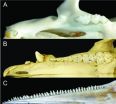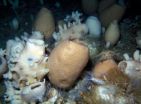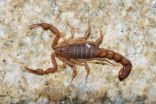(Press-News.org) Misshapen cell nuclei are frequently observed in the cells of people with cancer and other diseases, but what causes the abnormality -- and why it is associated with certain disorders -- has remained unclear.
Researchers at Northwestern University have recently developed a mathematical model that sheds light on the defect by clarifying the mechanisms that cause bulges known as "blebs" in cells' nuclear membranes. The research -- a collaboration between experts at the McCormick School of Engineering and Applied Science and the Feinberg School of Medicine -- could be a step toward bleb prevention, which may ultimately provide potential therapies for related diseases.
A paper describing the research, titled "Mechanical Model of Blebbing in Nuclear Lamin Meshworks," was published Feb. 11 in the Proceedings of the National Academy of Sciences USA (PNAS).
"Changes in the shape of the nucleus are indicative of a range of pathologies, including the premature aging disorder Hutchinson-Gilford progeria syndrome, Emery–Dreifuss muscular dystrophy and some cancers," said Monica Olvera de la Cruz, the corresponding author of the paper. "Our research suggests that blebbing may be the result of an imbalance between the various proteins that constitute the nuclear lamina."
She is a Lawyer Taylor Professor, professor of materials science and engineering in the McCormick School and professor of chemistry in the Weinberg College of Arts and Sciences.
The nucleus -- the control center of the cell, the keeper of genetic material and overseer of cell growth and reproduction -- is covered by a nuclear envelope consisting of a double membrane and an underlying structure called the nuclear lamina that surrounds the surface of the nucleus and gives it shape. In addition to its mechanical support, the lamina helps regulate cell division and organize genetic material.
In the majority of healthy cells, the nucleus appears smooth and maintains an overall spherical shape, but abnormal nuclear shapes characterized by blebs have been observed in the cells of people suffering from some forms of cancer and other diseases.
In mammals, the lamin meshworks that make up the nuclear lamina consist of mainly two types of lamin proteins, known as types A and B, which are wrapped like two nets around the nucleus. Under normal conditions, the A-type and B-type lamins co-exist throughout the sphere, creating a healthy lamina of approximately even thickness throughout.
But when one of the B-type lamins is depleted, researchers found the A-type and B-type lamins begin to segregate from one another, resulting in an uneven mesh layer with altered mechanical properties. In some regions, the lamina's fibers begin to gap and separate, giving rise to nuclear blebs, bulges in the cell's nuclear envelope.
The nuclear lamins, especially the A-type lamins, are now considered to be major building blocks of nuclear architecture and are thus involved in numerous important nuclear functions. Much of the recent information on the functions of the nuclear lamins comes from findings demonstrating that many different human diseases are caused by hundreds of mutations in the nuclear lamin A gene. Many of these diseases are accompanied by changes in nuclear shape and altered lamin organization.
"This study helps us to begin to understand how these abnormal shapes are formed," said Robert D. Goldman, the Stephen Walter Ranson Professor of Cell and Molecular Biology, chair of the department of cell and molecular biology at the Feinberg School, and one of the paper's authors. "Collaborations between physicists and cell biologists are beginning to reveal new insights into these normal and abnormal cells."
Enabling some of those new insights, the Northwestern researchers designed an energy-minimizing continuum elastic model that enabled them to produce structures with comparable shapes and patterns as those found in naturally occurring pathological nuclei.
###
Other co-authors of the paper are Chloe M. Funkhouser (lead author) and Rastko Sknepnek from McCormick's department of materials science and engineering and Takeshi Shimi and Anne E. Goldman from Feinberg's department of cell and molecular biology.
In fight against cancer, a closer look at nuclear blebbing
Researchers gain insight into abnormally shaped cell nuclei of people with cancer
2013-02-19
ELSE PRESS RELEASES FROM THIS DATE:
Nesting site protection 'key to save turtles from climate change'
2013-02-19
International marine scientists today warned it will be vital to protect key marine turtle nesting grounds and areas that may be suitable for turtle nesting in the future to ensure that the marine reptiles have a better chance of withstanding climate change.
A new study reveals that some turtle populations in the West Indian Ocean, Northeast Indian Ocean, North Pacific Ocean, East Atlantic Ocean and the East Pacific Ocean are among the least likely to recover from the impacts of climate change. Mariana_19feb_2
"To give marine turtles a better chance of coping with climate ...
5-ALA fluorescence guides resection of recurrent glioblastoma multiforme
2013-02-19
Charlottesville, VA, February 19, 2013. Neurosurgeons from UC San Francisco describe the use of 5-aminolevulinic acid (5-ALA) fluorescence in guiding resection of recurrent glioblastoma multiforme (GBM). Ingestion of 5-ALA by a patient before surgery leads to fluorescence of tumor cells intraoperatively in response to certain wavelengths of light. This can provide information not necessarily available through magnetic resonance imaging (MRI), the standard mode of imaging used to detect primary and recurrent GBMs. The additional information provided by 5-ALA fluorescence ...
How the whale got its teeth
2013-02-19
Whales are mammals, but they don't look like the mammals living around us, as they have a triangular fluke for tail, no hind legs and no body hair. And inside their mouths, their teeth are unfamiliar too – being much simpler and 'peg like'. A multidisciplinary team of researchers have now married together the fossil record and the embryonic development process to investigate how the whale got its teeth.
Most mammals have four kinds of teeth, each shaped for specific tasks. In most mammals there are wedge-shaped incisors, a pointy canine, and premolars and molars with ...
Stillbirth in Inuit and First Nations women higher than for non-Aboriginal residents
2013-02-19
Stillbirth rates in First Nations and Inuit populations in Quebec are higher than in the general population, especially in late gestation and at term, found a new study in CMAJ (Canadian Medical Association Journal).
"Aboriginal populations in Canada [First Nations and Inuit] rank at the top of the list of disadvantaged groups with the highest rates of stillbirth in the Western world," writes Dr. Nathalie Auger, Institut national de santé publique du Québec, with coauthors. Rates are 2 times those of the non-Aboriginal population.
Researchers looked at data on 9983 ...
Unplanned hospitalization more likely in people with several illnesses, mental health conditions
2013-02-19
People with multiple illnesses are much more likely to be admitted to hospital unexpectedly, and mental health issues and economic hardship further increase the likelihood, according to a study in CMAJ (Canadian Medical Association Journal).
"We provide strong evidence that physical multimorbidity substantially affects the use of acute hospital services, including admissions considered potentially preventable through management of optimal primary care," writes Dr. Rupert Payne, Cambridge Centre for Health Services Research, University of Cambridge, Cambridge, United Kingdom. ...
There's room for improvement in women's heart disease awareness
2013-02-19
The number of women aware that heart disease is the leading cause of death has nearly doubled in the last 15 years, but that knowledge still lags in minorities and younger women, according to a new study in the American Heart Association journal Circulation.
Researchers comparing women's views about heart disease in 1997 and today, found:
In 2012, 56 percent of women identified heart disease as the leading cause of death compared with 30 percent in 1997.
In 1997, women were more likely to cite cancer than heart disease as the leading killer (35 percent versus 30 ...
Data paper describes Antarctic biodiversity data gathered by 90 expeditions since 1956
2013-02-19
A new peer-reviewed data paper offers a comprehensive, open-access collection of georeferenced biological information about the Antarctic macrobenthic communities. The term macrobenthic refers to the visible-for-the-eye organisms that live near or on the sea bottom such as echinoderms, sponges, ascidians, crustaceans. The paper will help in coordinating biodiversity research and conservation activities on species living near the ocean bottom of the Antarctic.
The data paper "Antarctic macrobenthic communities: A compilation of circumpolar information", published in the ...
Phosphorus starvation linked to symptoms of citrus disease Huanglongbing in new study
2013-02-19
The citrus disease Huanglongbing (HLB), meaning "yellow shoot disease" in Chinese and also called citrus greening in English-speaking countries, is the most destructive disease threatening the citrus industry worldwide. Powerful diagnostic tools and management strategies are desired to control it. A new study, 'Small RNA profiling reveals phosphorus deficiency as a contributing factor in symptom expression for citrus Huanglongbing disease', published online today (Friday) in the journal Molecular Plant profiled small Ribonucleic Acids (sRNAs) from both diseased and healthy ...
Moffitt researchers say silencing of retinoblastoma gene regulates differentiation of myeloid cells
2013-02-19
Researchers at the Moffitt Cancer Center have found a potential mechanism by which immune suppressive myeloid-derived suppressor cells can prevent immune response from developing in cancer. This mechanism includes silencing the tumor suppressor gene retinoblastoma 1 or Rb1. Their data explains a new regulatory mechanism by which myeloid-derived suppressor cells are expanded in cancer.
Their study appeared in a recent issue of Nature Immunology.
According to the authors, two kinds of myeloid-derived suppressor cells - monocytic M-MDSCs and granulocytic PMN-MDSCs - regulate ...
New scorpion discovery near metropolitan Tucson, Arizona
2013-02-19
A new species of scorpion, Vaejovis brysoni, was found in the Santa Catalina Mountains in southern Arizona. Another scorpion of the same group also inhabits this mountain range, making this the first documented case of two vorhiesi group species distributed on the same mountain. The study was published in the open access, peer-reviewed journal Zookeys.
These mountains overlook the city of Tucson, Arizona. Amazingly, in the 21st century, there are still new species to be discovered right here in the United States. What is even more surprising is that the new species was ...
LAST 30 PRESS RELEASES:
The Lancet: COVID-19 vaccine hesitancy decreased over time, though mistrust persists among certain groups, study of over 1 million people in England suggests
Psychosis patients ‘living in metaphor’ -- new study radically shifts ideas about delusions
Clinical trial in Ethiopia targets the trachoma scourge
Open-sourcing the future of food
Changes in genetic structure of yeast lead to disease-causing genomic instabilities
UC San Diego Health Sciences Grant Writing Course helps launch successful research careers
Study: Many head and neck cancer trials end early. Why?
Tufts vice provost for research named Foreign Fellow of Indian National Science Academy
New model improves prediction of prostate cancer death risk
Two wrongs make a right: how two damaging variants can restore health
Overlooked decline in grazing livestock brings risks and opportunities
Using rare sugars to address alcoholism
Research alert: New vulnerability identified in aggressive breast cancer
Ruth Harris honored with SSA Distinguished Service Award
Treasure trove of data on aging publicly accessible
Trees4Adapt project to address risks from climate change and biodiversity loss through tree-based solutions
Nature Communications study from the Lundquist Institute identifies molecular mechanism underlying peripartum cardiomyopathy
Pennington Biomedical’s Dr. Gang Hu appointed to NIH Reproductive, Perinatal and Pediatric Health Review Group
World-first project shows great promise to treat low eye pressure
New technique puts rendered fabric in the best light
Brain cancer digital twin predicts treatment outcomes
Cat disease challenges what scientists thought about coronaviruses
Paulson Family Foundation makes an additional $19 million donation to Hebrew University to fund a new building for electrical engineering. Together with its previous gift brings the total donation to
Canada–Estonia partnership advances community-centered clean energy
Sandia’s economic impact sets record for 17th consecutive year
Researchers uncover how tumors become resistant to promising p53-targeted therapy
Aligning games and sets in determining tennis matches
UOC research team develops method to evaluate apps for treating depression
Extreme heat waves disrupt honey bee thermoregulation and threaten colony survival
New brain study explains how binge drinking contributes to long-lasting negative feelings
[Press-News.org] In fight against cancer, a closer look at nuclear blebbingResearchers gain insight into abnormally shaped cell nuclei of people with cancer


